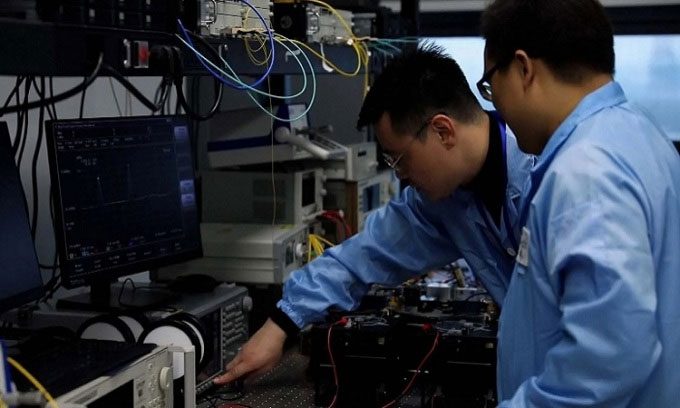Chinese Researchers Successfully Test Real-Time Wireless Transmission at 100 Gigabits per Second.
A research team from the Second Institute of the China Aerospace Science and Technology Corporation has conducted the first real-time wireless transmission test for 6G technology, marking a significant advancement in the development of the successor to 5G networks. The experiment utilized terahertz orbital angular momentum communication technology, as reported by the South China Morning Post on April 25.

Researchers analyzing data on 6G networks. (Photo: SCMP).
In the experiment, the research team employed a special antenna to emit four different beam patterns at a frequency of 110 GHz. With these patterns, they achieved real-time wired communication at a speed of 100 gigabits per second over a 10 GHz bandwidth, significantly enhancing bandwidth efficiency. According to them, this technology could also be applied for short-range transmissions, supporting high-speed communication between lunar/mars landers and spacecraft.
Terahertz refers to the frequency range from 100 GHz to 10 THz in the electromagnetic spectrum. Due to its higher frequency, terahertz communication can carry more information, transmit data faster, and provide greater security. It also holds significant potential for 6G networks, high-speed internet, and security applications, especially in complex military environments. However, the higher information density often comes with increased noise levels. Terahertz wave communication is more susceptible to signal loss and degradation over greater distances. While the research team did not disclose specific technology details, they hope to overcome these challenges in practical applications.
Another advancement applied by the researchers is orbital angular momentum (OAM) transmission, where technology encodes additional information into electromagnetic waves. Thanks to OAM, multiple signals can be transmitted simultaneously at the same frequency without interruption, allowing for more efficient use of available spectrum, increasing data transmission capacity, and enhancing communication speeds.
The research team also utilized wireless backhaul technology, which connects base stations to the core network. In mobile networks, data needs to be transmitted between user devices, base stations, and the core network. Backhaul refers specifically to the process of transmitting user data received by the base station to the core network. Experts predict that by 2023, over 62% of base stations worldwide will utilize wireless backhaul technology.
The researchers have chosen terahertz orbital angular momentum communication as a breakthrough target. In the future, the maximum transmission speed of 6G networks is expected to reach one terabit per second. The 6G network is anticipated to be faster and more reliable than current 5G technology, providing low latency and more efficient spectrum use. Such a network is likely to employ new technologies like terahertz waves to enhance wireless communication, enabling applications such as high-resolution virtual reality, real-time holographic communication, and data-intensive tasks that current technologies cannot support.


















































